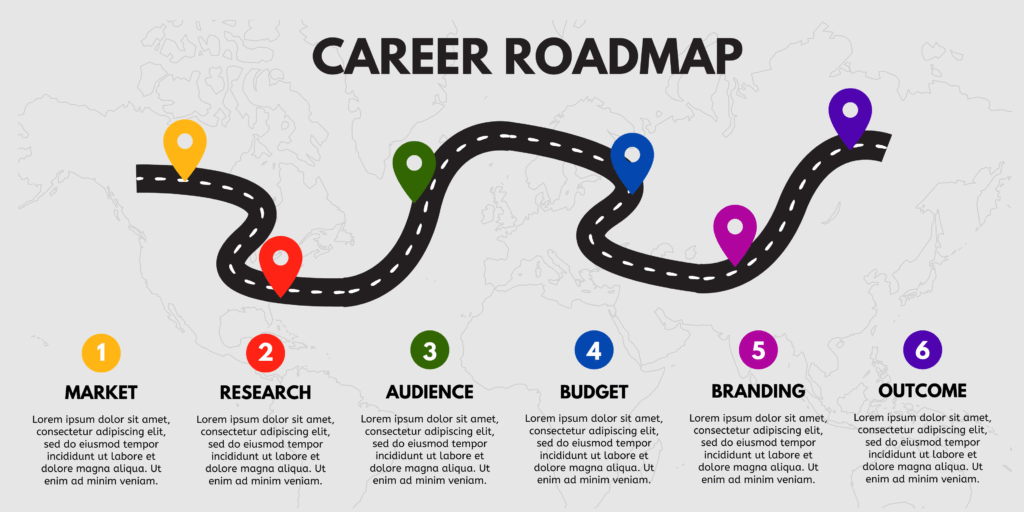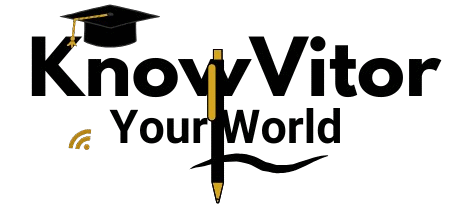Why Intentional Career Planning Matters
In a fast-changing job market, careers don’t “happen”—they’re built. Strategic planning turns uncertainty into a series of clear milestones you can execute. Think of it as trading guesswork for evidence-based decisions: you identify your strengths, validate market demand, design learning paths, and review progress on a schedule.
Key takeaway: A career roadmap converts big ambitions into flexible, measurable, repeatable steps.

How a Career Roadmap Works (GPS for Your Career
A career roadmap connects three points:
- Baseline: where you are now (skills, experience, constraints)
- Destination: roles, impact, income, and lifestyle you want
- Routes: skills to learn, projects to ship, people to meet, and timelines to follow
Your plan balances clarity (goals) with flexibility (iterations). That’s why you’ll set SMART goals, run 90-day sprints, and review results every two weeks.
Step 1: Self-Discovery and Aptitude Insights
Interests tell you what excites you; aptitudes tell you what you’re naturally good at. Both matter. Use an aptitude assessment (e.g., YouScience or a similar tool) to uncover strengths such as:
- Analytical reasoning (problem solving)
- Spatial visualization (design/engineering)
- Inductive reasoning (pattern finding)
- Numerical ability (quant/finance/data)
- Vocabulary/communication (writing, sales, leadership)
Make it actionable:
- List your top five aptitudes and three interests.
- Highlight overlaps that suggest promising roles.
- Keep this 1-page snapshot visible as you research industries and set goals.
Pro tip: Print your results or save them in a pinned Notion/Docs page; refer back whenever you choose courses, projects, or job postings.
Step 2: Define Career Goals (SMART + Values)
Set 1–3 outcome goals for 6–12 months. Make them SMART (Specific, Measurable, Achievable, Relevant, Time-bound) and aligned with your values.
Example SMART goal:
“Become a Data Analyst in 12 months at a mid-sized tech firm; complete two portfolio projects (SQL + BI), gain internship experience, and increase salary by 15%.”
Add lead measures you control weekly (study hours, applications, networking touches) and check they fit your lifestyle priorities (e.g., remote work, learning pace, relocation openness).
Questions to refine direction:
- What environments energize me (startups, corporates, remote, field-based)?
- Is work-life balance or rapid advancement more important this year?
- What impact do I want my work to create?
Step 3: Industry Research & Market Analysis
Explore multiple industry clusters where your aptitudes can shine. Typical clusters include:
- Technology & Engineering: analytics, software, cybersecurity, product
- Healthcare & Life Sciences: research, clinical data, med-tech
- Finance & Business: financial analysis, consulting, operations
- Creative & Design: UX/UI, content, brand, product design
Research checklist (repeat for each target industry):
- Growth trends and hiring outlook
- Salary ranges by level and location
- Must-have technical and soft skills
- Typical career paths and time-to-promotion
- Education/certifications that matter
- Geographic hubs and remote options
Where to research: official labor stats, professional associations, credible job boards, company career pages, LinkedIn insights, and industry journals. Keep brief notes—a simple one-pager per industry will guide smart decisions later.
Step 4: Skills Gap Analysis & Development Plan
From 5–10 real job descriptions, extract a skills list for your target role, then label each as:
- N (Now): solid, demonstrable
- L (Learning): some exposure; needs depth
- G (Gap): must acquire from scratch
Build a practical development plan
Immediate (0–6 months):
- Enroll in 1–2 core courses (keep a cap to avoid overwhelm)
- Join a club/community or volunteer for a project using the target skill
- Ship one mini-project with a short case study
Medium-term (6–18 months):
- Internship or part-time role
- 1 certification that employers actually recognize in your niche
- Lead a small initiative to practice communication and stakeholder skills
Long-term (18+ months):
- Advanced projects that solve real business problems
- Deeper specialization (e.g., domain analytics, mobile UI, risk modeling)
- Speaking/writing to build credibility (blog posts, meetups)
Output beats input. Courses matter, but projects with a clear problem → approach → result are what get you interviews.
Step 5: Use AI Tools the Right Way
AI can speed up planning when used intentionally.
What AI can do
AI in education is also helpful for today’s users
- Career matching: suggest roles based on your profile
- Market scanning: summarize skills in demand and salary bands
- Learning paths: curate resources and milestones
- Drafting help: refine resumes, outreach messages, and interview answers
How to prompt effectively (examples)
- Profile setup:
“I’m a business major (GPA 3.6). High aptitude in analytical reasoning and numerical ability. Interested in fintech data roles; prefer collaborative teams and good work-life balance. Help me design a 12-month plan to become a data analyst, with monthly milestones and 2 portfolio projects.” - Role analysis:
“List the top 10 skills hiring managers expect for entry-level fintech data analysts in 2025, ranked by importance. Add 2 project ideas and metrics to showcase impact.” - Interview prep:
“Create 8 behavioral interview questions for a junior data analyst and bullet strong, quantifiable answers using the STAR format.”
Privacy note: Before pasting content into any AI tool, remove personal identifiers (full name, phone, address, IDs).
Step 6: 90-Day Action Plan (Sprints)
Break the year into four 90-day sprints. Each sprint has a theme and measurable outputs.
| Sprint | Focus | Outcomes | Weekly Rhythm |
|---|---|---|---|
| 1: Foundation (Days 1–90) | Clarify direction, start skills | 1 skills course, 1 mini-project, updated LinkedIn/resume | 5–7 study hrs, 1–2 project sessions |
| 2: Build (Days 91–180) | Deeper practice + visibility | 1 portfolio project, 5–7 tailored applications/wk, 3 networking touches/wk | Project + applications + outreach |
| 3: Experience (Days 181–270) | Real-world exposure | Internship/part-time, advanced coursework, 2 informational interviews/mo | 1 mock interview/wk |
| 4: Convert (Days 271–360) | Interviews and offers | Polished portfolio, interview loop, negotiation prep | 5 targeted applications/wk, follow-ups |
Biweekly review (30 min): What worked? What didn’t? What changes for the next two weeks?
Step 7: Build a Professional Brand & Network
Personal brand essentials
- LinkedIn:
- Headline: target role + core skills + value (e.g., “Aspiring Product Analyst • SQL, A/B Testing • Turns data into decisions”)
- About: your story in 5–7 lines (motivations, skills, results)
- Activity: share project snippets, insights, or “build in public” updates twice a month
- Portfolio/Website (or Notion/GitHub):
- 2–3 projects with problem → approach → results, screenshots, and code or artifacts
- Short, skimmable write-ups with metrics (e.g., “reduced query time 40%,” “increased CTR 12%”)
Networking that doesn’t feel fake
- Build a 20-person pipeline (alumni, meetup speakers, teammates at target companies).
- Send 3–5 genuine messages per week: comment on their work, ask one precise question, or share a relevant resource.
- Follow up monthly with a quick update (“I just shipped X project—would love feedback on the dashboard.”)
Quality > quantity: You’re building relationships, not collecting contacts.
Step 8: Continuous Learning & Adaptation
Careers evolve. Keep your plan alive.
- Stay current: follow industry newsletters, standards, and thought leaders.
- Build future-ready skills: data literacy, AI fluency, communication, problem solving.
- Adapt on signal: if a skill becomes hot (or obsolete), adjust your plan this quarter—not next year.
Annual review: What did you achieve? What changed in the market? Which goals need an upgrade, and which experiments should you run next?
Metrics & Review: Track What Matters
Measure inputs you control and outputs you want:
- Learning: study hours/week; modules completed
- Output: projects shipped; case studies written; demos presented
- Pipeline: tailored applications; responses; screens; interviews; offers
- Brand: profile views; portfolio visits; Git commits
- Financial: salary band progress; freelance/side-project revenue
Cadence: biweekly quick check, monthly deeper review, quarterly sprint reset.
Common Pitfalls (and How to Avoid Them)
- Vague goals: “Get a good job” → specify role, timeline, salary band.
- Course collecting: No project = no proof. Attach output to every course.
- No review rhythm: Put recurring reviews on your calendar now.
- Spray-and-pray applications: Tailor to the job; align with keywords and impact.
- Ignoring soft skills: Communication and stakeholder management often decide promotions.
Copy-Ready Roadmap Template
Copy this into Notion/Docs and fill it out.
1) Destination (6–12 months)
- Target role/title:
- Salary/level aim:
- Success snapshot (one sentence):
2) Aptitudes & Strengths (Top 5)
3) Values & Constraints
- Work style (remote/hybrid/on-site):
- Learning pace/time budget:
- Relocation preference:
4) Skills Gap Map (N/L/G)
- Technical skills:
- Soft skills:
- Domain knowledge:
5) Development Plan
- Resource → Deliverable → Deadline
- Resource → Deliverable → Deadline
6) Portfolio Projects (Problem → Approach → Result)
- Project A:
- Project B:
7) Networking Pipeline (20 people)
- Name, role, company, next touch date:
8) 90-Day Sprint Plan
- Sprint goal:
- Weekly actions (learning, projects, outreach, applications):
9) Metrics & Review
- Biweekly notes (what worked/what changes)
CONCLUSION : A career roadmap works when it’s specific, output-driven, and reviewed often. Start with your aptitudes, define SMART goals, research the market, close skill gaps with projects, use AI wisely, and run your plan in 90-day sprints. The combination of clarity, execution, and iteration is what turns ambition into offers—and long-term, into a meaningful, resilient career.
1–3 clear goals for the next 6–12 months. Focus beats complexity.
Helpful, not mandatory. A public portfolio + consistent reviews can substitute early on. Seek a mentor once you’ve shipped initial projects.
As soon as you have 1–2 credible projects and a resume tailored to the role. Keep learning while applying; hiring cycles take weeks.

